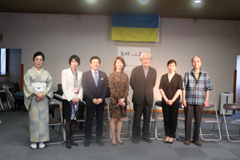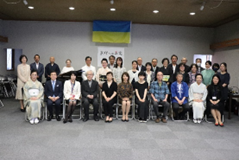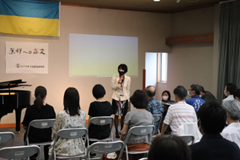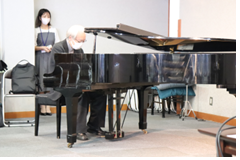Thank you After the holding of the ceremony “Love letters to Kyoto”
Yoshie Doi
 |
 |
| Winners and judges | Group photo of participants |
 |
 |
| Organizer greetings | The Jury Chairman Shoichi Inoue, piano performance and talk |
The award ceremony for “Love Letters to Kyoto”, which was solicited last year, was postponed due to the Korona. We have already sent the awards and supplementary prizes to the award winners, but we have continued to want to hold a love letter gathering instead of the awards ceremony. Thanks to you, we invited 50 people who are winners and the Kyo-Suzume related people to the event.
On June 18th, with the consideration of Inabado Byodo-ji Temple, which has been in business for over 1000 years, we were relieved to be able to rent the venue and hold it safely. I appreciate you sincerely.
Saeko Kiyotani is a mom of a 2-year-old twin and the second grade of elementary school, rushed to Kyoto with her parents while raising children. Yashue Tsuruta of the Landscape Award came from Okayama with her young lady. The heartwarming award, Niji Moritake was attended by a high school student from Ehime Prefecture.
In addition, Kuniyoshi Suzuki, who won the prize three times in a row in the Koibumi open call for participants, and this time also won the landscape prize and the Ninmari prize, came from Kanagawa. Thank you.
Kyo-Suzume is still 22 years old, but I have learned the deep culture and heart of Kyoto from the perspective of a sparrow at the site.
The driving force is that I love Kyoto. They said, “I have been energized by the land, culture, and history of Kyoto, and have analyzed it from the perspective of a timeless UFO from the perspective of a sparrow. I wanted to know more about Kyoto, which creates the energy to live. It feels like the new world of Kyoto has spread in front of you.
Looking back, the love letter to Kyoto started from the course of “Kyoto loved by Yasunari Kawabata” in the curriculum “Kyoto Ai Monogatari : Kyoto love story” of the Kyoto Suzume School in 2008. Impressed by the “Koto”, I thoroughly analyzed the “Koto”. From here, the movie “Koto” was born. I also wanted to give back to Dr. Yasunari, who beautifully depicts the charm, culture, lifestyle, and Saijiki of Kyoto.
“People can’t leave anything even if they die, but nature remains as it is. How can we preserve and protect this beautiful Japanese nature and pass on the ancient city of Kyoto to future generations? This is the theme from Yasunari Kawabata.” Professor Kaori Kawabata said these to me.
“The town where we can’t see the mountains is not Kyoto. We can’t see the mountains. We can’t see the mountains.”
The feelings of Dr. Yasunari, who was lamented, speak for the feeling that Kyoto people are living with peace of mind looking at the mountains 365 days a year.
In order for Kyoto, the town that has evolved in unison with nature, to continue to be the norm in the future, I continue to send out through love letters, and I also post a blog every week.
We are still in the process of giving back, but we would like to work with you to send the new world of Kyoto to the world and make it a source of energy for living. Thank you for your cooperation.
The end of document
